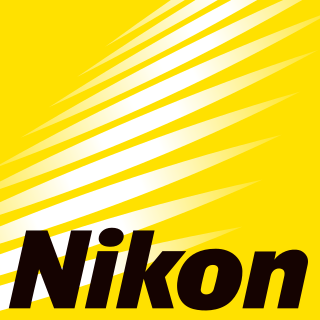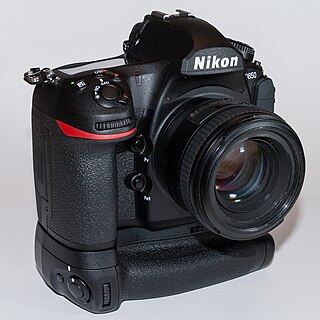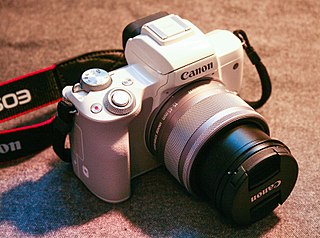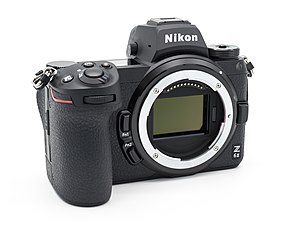
Nikon Corporation is an optics and photographic equipment manufacturer headquartered in Tokyo, Japan. The companies held by Nikon form the Nikon Group.

The Nikon D300S is a 12.3-megapixel DX format digital single-lens reflex camera (DSLR) announced by Nikon on 30 July 2009. It replaced the D300 as Nikon's flagship DX format DSLR adding HD video recording. It has some similarities to the Nikon D700, with the same resolution, but has a smaller, higher-density sensor. The D300s was superseded by the Nikon D500, announced on January 5, 2016.

The Nikon 1 series is a discontinued camera line from Nikon, originally announced on 21 September 2011. The cameras utilized Nikon 1-mount lenses, and featured 1" CX format sensors.

The Nikon Expeed image/video processors are media processors for Nikon's digital cameras. They perform a large number of tasks: Bayer filtering, demosaicing, image sensor corrections/dark-frame subtraction, image noise reduction, image sharpening, image scaling, gamma correction, image enhancement/Active D-Lighting, colorspace conversion, chroma subsampling, framerate conversion, lens distortion/chromatic aberration correction, image compression/JPEG encoding, video compression, display/video interface driving, digital image editing, face detection, audio processing/compression/encoding and computer data storage/data transmission.

CFexpress is a standard for removable media cards proposed by the CompactFlash Association (CFA). The standard uses the NVM Express protocol over a PCIe 3.0 interface with 1 to 4 lanes where 1 GB/s data can be provided per lane. There are multiple form factors that feature different PCIe lane counts. One of the goals is to unify the ecosystem of removable storage by being compatible with standards already widely adopted, such as PCIe and NVMe. There already is a wide range of controllers, software and devices that uses these standards, accelerating adoption.

The Nikon D850 is a professional-grade full-frame digital single-lens reflex camera (DSLR) produced by Nikon. The camera was officially announced on July 25, 2017, launched on August 24, 2017, and first shipped on September 8, 2017. Nikon announced it could not fill the preorders on August 28, 2017 and filled less than 10% of preorders on the first shipping day. It is the successor to the Nikon D810.

The Sony α7R III is a full-frame mirrorless interchangeable-lens camera manufactured by Sony. It was announced on 25 October 2017 as the successor to the Sony α7R II launched two years prior. The camera shares many features with the α7R II, including the same 42.2 MP resolution for still photography. It was superseded by the Sony α7R IV in July 2019.

The Sony α7 III is a full-frame mirrorless interchangeable-lens camera manufactured by Sony. It was announced on 26 February 2018 as the successor to the Sony α7 II and available April 10, 2018. Described by Sony as "the basic model," the camera shares many features with the high-end Sony α7R III and α9 models. It was succeeded by the Sony α7 IV, announced on October 21, 2021.

Nikon Z-mount is an interchangeable lens mount developed by Nikon for its mirrorless digital cameras. In late 2018, Nikon released two cameras that use this mount, the full-frame Nikon Z 7 and Nikon Z 6. In late 2019 Nikon announced their first Z-mount camera with an APS-C sensor, the Nikon Z 50. In July 2020 the entry-level full-frame Z 5 was introduced. In October 2020, Nikon announced the Nikon Z 6II and Nikon Z 7II, which succeed the Z 6 and Z 7, respectively. The APS-C lineup was expanded in July 2021, with the introduction of the retro styled Nikon Z fc, and in October 2021, Nikon unveiled the Nikon Z 9, which effectively succeeds the brand's flagship D6 DSLR. The APS-C lineup was further expanded with the Nikon Z 30, announced at the end of June 2022. The Nikon Z6III was announced in June 2024.

The Nikon Z 7 is a 45.7 megapixel full-frame mirrorless interchangeable-lens camera produced by Nikon. The camera was officially announced on August 23, 2018, for release in September 2018. It was the first camera to use Nikon's new Z-mount system; the second model, released in November 2018, was the 24.5 megapixel Nikon Z 6.

The Nikon Z 6 is a full-frame mirrorless interchangeable-lens camera produced by Nikon. The camera was officially announced on August 23, 2018, to be released in November. Nikon began shipping the Z 6 to retailers on November 16, 2018. This was the second camera to use Nikon's new Z-mount system after the release of the 45.75 megapixel Nikon Z 7 in September 2018.

The Sony α6400 is a digital camera announced on January 15, 2019. It is an APS-C mirrorless interchangeable lens camera (MILC) designed to be a mid-range mirrorless camera and acts as the successor to the α6300. Intended to target the vlogging community, the α6400 features a flip-up screen and aggressive pricing. It features the same 24 megapixel sensor seen in the α6500. At the time of release, the two most capable cameras in the α6000 series of cameras were the α6400 and the α6500. The α6500 features in-body image stabilization and a larger image buffer, but the α6400 is arguably more advanced as the newer model. This is largely due to its increased processing power, real-time eye AF, and real-time tracking. These features, for example, can not be added to the α6300 via a firmware update, as it would be too demanding on the processor.

The Nikon D780 is a full-frame DSLR camera announced by Nikon on January 6, 2020. It was released for purchase on January 23, 2020. It is the successor to the Nikon D750 and has incorporated a lot of technologies from mirrorless Z6 camera.

The Canon EOS R5 is a professional full-frame mirrorless interchangeable-lens camera officially announced by Canon on July 9, 2020 alongside the lower-resolution EOS R6 and various new RF mount lenses. While it is not a direct successor to any of Canon's previous mirrorless cameras, it does have clear improvements and advantages over the EOS R, namely: a new DIGIC X processor and sensor, 8K video capture, a new autofocus system, and the ability to take videos with 10-bit colours. The camera is available as body only, or with the Canon RF 24-105mm f/4L IS USM lens.

The Fujifilm X-T4 is a mirrorless interchangeable-lens digital camera announced on February 25, 2020. It has a backside-illuminated X-Trans CMOS 4 APS-C sensor and an X-Processor 4 quad core processor and uses the Fujifilm X-mount. The X-T4 is a weather-resistant camera equipped with a higher-capacity battery designed to last longer than the X-T3. It is the successor to 2018's X-T3, which is a little smaller and lighter.

The Canon EOS R6 is an advanced full-frame mirrorless interchangeable-lens camera produced by Canon. The camera was announced by Canon on July 9, 2020, alongside the EOS R5.

The Nikon Z 7II is a high-end full-frame mirrorless interchangeable-lens camera (MILC) produced by Nikon, and is the successor to the Nikon Z 7. The camera was officially announced on October 14, 2020, alongside the Nikon Z 6II, and became available for purchase on November 5. It uses Nikon's Z-mount system.

The Canon EOS M50 Mark II, also known as the EOS Kiss M2 in Japan, is a 24.1 megapixels entry-mid-level mirrorless interchangeable-lens camera announced by Canon on October 14, 2020. As a part of their Mirrorless Canon EOS M Line, it is the successor to the Canon EOS M50, sitting above the entry-level Canon EOS M200 and below the enthusiast-oriented Canon EOS M6 Mark II.

The Canon EOS R7 is a high-end semi-professional APS-C mirrorless interchangeable-lens camera produced by Canon. The camera was announced by Canon on May 24, 2022 and released in Japan on June 23, 2022 Alongside the Canon EOS R10, the R7 is the first of two APS-C cameras in Canon's EOS R lineup. Two RF-S mount lenses were offered as kit lenses with the R7: the RF-S 18-150mm f/3.6-6.3 IS STM and the RF-S 18-45 f/4.5-6.3 IS STM.

The Sony α7 IV is a full-frame mirrorless interchangeable-lens camera manufactured by Sony. It was announced on 21 October 2021 as the successor to the Sony α7 III. Featuring a new 34.1MP back-illuminated CMOS sensor inside, latest BIONZ XR™ image processor, Real-Time Eye AF tracking and 4K 60p video with Super 35mm mode




















